Landscape Characteristics and Ecological Risk Assessment Based on Multi-Scenario Simulations: A Case Study of Yancheng Coastal Wetland, China
Abstract
1. Introduction
2. Materials and Methods
2.1. Study Area
2.2. Data Sources
2.3. Methods
2.3.1. CA-Markov Model
2.3.2. Accuracy Verification of Landscape Simulation
2.3.3. Landscapes Ecological Risk Assessment (ERS) Model
2.3.4. Spatial Analysis Method of Ecological Risks
2.3.5. Multi-Scenario Landscape Simulation and ERS Framework
3. Results
3.1. Multi-Scenario Landscape Simulation Based on CA-Markov Model
3.2. Landscape Spatial Structural Characteristics of Yancheng Coastal Wetland
3.3. Landscape Ecological Risk Assessment of Yancheng Coastal Wetland
3.3.1. Spatiotemporal Change Characteristics of Landscape Ecology
3.3.2. Spatiotemporal Change Characteristics of Landscape Ecological Risks under Multi-Scenario
3.3.3. Transfer Changes of Landscape Ecological Risks
4. Discussion
4.1. Applications and Improvement of Landscape Simulation Methods
4.2. Spatial-Temporal Distribution Differences of Landscape Ecological Risks
5. Conclusions
Author Contributions
Funding
Acknowledgments
Conflicts of Interest
Appendix A
| Satellite | Sensors | Path/Row | Date (yy-mm-dd) | Satellite | Sensors | Path/Row | Date (yy-mm-dd) |
|---|---|---|---|---|---|---|---|
| Landsat5 | TM | 120/36 | 1991-11-19 | Landsat5 | TM | 119/37 | 1991-11-28 |
| Landsat5 | TM | 120/36 | 2000-12-13 | Landsat5 | TM | 119/37 | 2000-12-06 |
| Landsat5 | TM | 120/36 | 2004-12-08 | Landsat5 | TM | 119/37 | 2004-11-15 |
| Landsat5 | TM | 120/36 | 2008-12-19 | Landsat5 | TM | 119/37 | 2009-01-13 |
| Landsat8 | OLI | 120/36 | 2013-12-01 | Landsat8 | OLI | 119/37 | 2013-12-10 |
| Landsat8 | OLI | 120/36 | 2017-12-01 | Landsat8 | OLI | 119/37 | 2017-12-10 |
| Landscape Types | Calss1 | Calss2 | Calss3 | Calss4 | Calss5 | Calss6 | Calss7 | Calss8 | Calss9 | Calss10 |
|---|---|---|---|---|---|---|---|---|---|---|
| Calss1 | 0.8604 | 0.0532 | 0.0000 | 0.0002 | 0.0509 | 0.0021 | 0.0000 | 0.0048 | 0.0097 | 0.0186 |
| Calss2 | 0.0016 | 0.7755 | 0.0000 | 0.0000 | 0.0352 | 0.1080 | 0.0000 | 0.0078 | 0.0101 | 0.0618 |
| Calss3 | 0.0000 | 0.0000 | 0.8319 | 0.0000 | 0.0000 | 0.1667 | 0.0001 | 0.0000 | 0.0000 | 0.0012 |
| Calss4 | 0.0001 | 0.0000 | 0.0000 | 0.8903 | 0.0500 | 0.0548 | 0.0000 | 0.0004 | 0.0043 | 0.0001 |
| Calss5 | 0.0001 | 0.0002 | 0.0000 | 0.0003 | 0.8739 | 0.1083 | 0.0000 | 0.0004 | 0.0043 | 0.0041 |
| Calss6 | 0.0003 | 0.0002 | 0.0000 | 0.0002 | 0.2075 | 0.7611 | 0.0001 | 0.0065 | 0.0066 | 0.0041 |
| Calss7 | 0.0000 | 0.0006 | 0.0000 | 0.0000 | 0.0006 | 0.0048 | 0.8958 | 0.0000 | 0.0751 | 0.0232 |
| Calss8 | 0.0005 | 0.0002 | 0.0000 | 0.0000 | 0.0012 | 0.0323 | 0.0008 | 0.8658 | 0.0570 | 0.0422 |
| Calss9 | 0.0008 | 0.0008 | 0.0000 | 0.0002 | 0.1604 | 0.0700 | 0.0075 | 0.0052 | 0.6746 | 0.0805 |
| Calss10 | 0.0011 | 0.0012 | 0.0000 | 0.0000 | 0.0733 | 0.0830 | 0.0003 | 0.0014 | 0.0048 | 0.8348 |
| Landscape Types | Calss1 | Calss2 | Calss3 | Calss4 | Calss5 | Calss6 | Calss7 | Calss8 | Calss9 | Calss10 |
|---|---|---|---|---|---|---|---|---|---|---|
| Calss1 | 225,029 | 13,916 | 0 | 55 | 13,310 | 557 | 3 | 1263 | 2544 | 4857 |
| Calss2 | 806 | 396,543 | 1 | 7 | 17,975 | 55,222 | 7 | 3988 | 5173 | 31,609 |
| Calss3 | 0 | 4 | 130,883 | 0 | 6 | 26,221 | 18 | 0 | 2 | 189 |
| Calss4 | 171 | 0 | 0 | 1,121,154 | 62,993 | 69,024 | 10 | 472 | 5398 | 101 |
| Calss5 | 85 | 152 | 4 | 250 | 832,141 | 103,092 | 67 | 6178 | 6294 | 3834 |
| Calss6 | 50 | 38 | 3 | 35 | 39,611 | 145,314 | 23 | 2094 | 552 | 3212 |
| Calss7 | 0 | 44 | 0 | 0 | 44 | 377 | 70,060 | 0 | 5871 | 1817 |
| Calss8 | 67 | 28 | 0 | 0 | 177 | 4732 | 120 | 126,861 | 8350 | 6189 |
| Calss9 | 38 | 39 | 0 | 10 | 7699 | 3358 | 358 | 250 | 32,383 | 3866 |
| Calss10 | 188 | 209 | 0 | 0 | 12,712 | 14,391 | 54 | 238 | 831 | 144,691 |
References
- Turner, M.G. Landscape Ecology: What Is the State of the Science? Ann. Rev. Ecol. Syst 2005, 36, 319–344. [Google Scholar] [CrossRef]
- Wu, J. The key research topics in landscape ecology. Acta Ecol. Sin. 2004, 24, 2074–2076. [Google Scholar]
- Dadashpoor, H.; Azizi, P.; Moghadasi, M. Land use change, urbanization, and change in landscape pattern in a metropolitan area. Sci. Total Environ. 2019, 655, 707–719. [Google Scholar] [CrossRef] [PubMed]
- Hemstrom, M.A.; Merzenich, J.; Reger, A.; Wales, B. Integrated analysis of landscape management scenarios using state and transition models in the upper Grande Ronde River Subbasin, Oregon, USA. Landsc. Urban Plan. 2007, 80, 198–211. [Google Scholar] [CrossRef]
- Costanza, R. Ecosystem health and ecological engineering. Ecol. Eng. 2012, 45, 24–29. [Google Scholar] [CrossRef]
- Wu, J. Landscape sustainability science: Ecosystem services and human well-being in changing landscapes. Landsc. Ecol. 2013, 28, 999–1023. [Google Scholar] [CrossRef]
- Jiao, M.; Hu, M.; Xia, B. Spatiotemporal dynamic simulation of land-use and landscape pattern in the Pearl River Delta, China. Sustain. Cities Soc. 2019, 49, 101581. [Google Scholar] [CrossRef]
- Wu, J. Key concepts and research topics in landscape ecology revisited: 30 years after the Allerton Park workshop. Landsc. Ecol. 2013, 28, 1–11. [Google Scholar] [CrossRef]
- Cao, Q.; Zhang, X.; Lei, D.; Guo, L.; Sun, X.; Wu, J. Multi-scenario simulation of landscape ecological risk probability to facilitate different decision-making preferences. J. Clean. Prod. 2019, 227, 325–335. [Google Scholar] [CrossRef]
- Topping, C.J.; Dalby, L.; Valdez, J.W. Landscape-scale simulations as a tool in multi-criteria decision making to support agri-environment schemes. Agric. Syst. 2019, 176. [Google Scholar] [CrossRef]
- Liu, X.; Xun, L.; Xia, L.; Xu, X.; Wang, S. A future land use simulation model (FLUS) for simulating multiple land use scenarios by coupling human and natural effects. Landsc. Urban Plan. 2017, 168, 94–116. [Google Scholar] [CrossRef]
- Wehner, S.; Herrmann, S.; Berkhoff, K. CLUENaban—A land use change model combining social factors with physical landscape factors for a mountainous area in Southwest China. Ecol. Indic. 2014, 36, 757–765. [Google Scholar] [CrossRef]
- Silva, E.A.; Clarke, K.C. Calibration of the SLEUTH urban growth model for Lisbon and Porto, Portugal. Comput. Environ. Urban Syst. 2002, 26, 525–552. [Google Scholar] [CrossRef]
- Li, X.; Li, D.; Liu, X.P. Geographical Simulation and Optimization System (GeoSOS) and Its Application in the Analysis of Geographic National Conditions. Acta Geod. Cartogr. Sin. 2017, 46, 1598–1608. [Google Scholar]
- Hamad, R.; Balzter, H.; Kolo, K. Predicting Land Use/Land Cover Changes Using a CA-Markov Model under Two Different Scenarios. Sustainability 2018, 10, 3421. [Google Scholar] [CrossRef]
- Behera, M.D.; Borate, S.N.; Panda, S.N.; Behera, P.R.; Roy, P.S. Modelling and analyzing the watershed dynamics using Cellular Automata (CA)–Markov model – A geo-information based approach. J. Earth Syst. Sci. 2012, 121, 1011–1024. [Google Scholar] [CrossRef]
- Lin, C.; Zhang, X.; Wang, T.; Li, Z.; Cai, C. Spatial-temporal evolution and prediction of urban landscape pattern and habitat quality based on CA-Markov and InV EST model. Chin. J. Appl. Ecol. 2018, 29, 4106–4118. [Google Scholar]
- Bhagawat, R.; Zhang, L.; Hamidreza, K.; Wang, N.; Lin, Y. Monitoring and Modeling of Spatiotemporal Urban Expansion and Land-Use/Land-Cover Change Using Integrated Markov Chain Cellular Automata Model. ISPRS Int. J. Geo-Inf. 2017, 6, 288. [Google Scholar]
- Carlson, M.; Browne, D.; Callaghan, C. Application of land-use simulation to protected area selection for efficient avoidance of biodiversity loss in Canada’s western boreal region. Land Use Policy 2019, 82, 821–831. [Google Scholar] [CrossRef]
- Yue, D.X.; Yang, C.; Jiang, B.H.; Guo, J.J.; Xu, X.F. Spatio-temporal pattern prediction of the biocapacity in the Shiyang River Basin on the basis of the CA-Markov model. Acta Ecol. Sin. 2019, 39, 1993–2003. [Google Scholar]
- Hu, B.S.; Zhang, H.Y. Simulation of Land-use Change in Poyang Lake Region Based on CA-Markov Model. Resour. Environ. Yangtze Basin 2018, 27, 32–44. [Google Scholar]
- Jing, Y.Q.; Zhang, F.; Zhang, Y. Change and prediction of the land use/cover in Ebinur Lake Wetland Nature Reserve based on CA-Markov model. Chin. J. Appl. Ecol. 2016, 27, 3649–3658. [Google Scholar]
- Mitsova, D.; Shuster, W.; Wang, X. A cellular automata model of land cover change to integrate urban growth with open space conservation. Landsc. Urban. Plan. 2011, 99, 141–153. [Google Scholar] [CrossRef]
- Yu, H.; Liu, X.; Kong, B.; Li, R.; Wang, G. Landscape ecology development supported by geospatial technologies: A review. Ecol. Inform. 2019, 51, 185–192. [Google Scholar] [CrossRef]
- Jiang, P.; Li, M.; Lv, J. The causes of farmland landscape structural changes in different geographical environments. Sci. Total Environ. 2019, 685, 667–680. [Google Scholar] [CrossRef]
- Landis, W.G. Twenty Years Before and Hence; Ecological Risk Assessment at Multiple Scales with Multiple Stressors and Multiple Endpoints. Hum. Ecol. Risk Assess. 2003, 9, 1317–1326. [Google Scholar] [CrossRef]
- Xing, L.; Hu, M.; Wang, Y. Integrating ecosystem services value and uncertainty into regional ecological risk assessment: A case study of Hubei Province, Central China. Sci. Total Environ. 2020, 740, 140126. [Google Scholar] [CrossRef]
- Galic, N.; Schmolke, A.; Forbes, V.; Baveco, H.; Brink, P.J.V.D. The role of ecological models in linking ecological risk assessment to ecosystem services in agroecosystems. Sci. Total Environ. 2012, 415, 93–100. [Google Scholar] [CrossRef]
- Gaines, K.F.; Porter, D.E.; Dyer, S.A.; Wein, G.R.; Pinder, J.E.; Brisbin, I.L. Using Wildlife as Receptor Species: A Landscape Approach to Ecological Risk Assessment. Environ. Manag. 2004, 34, 528–545. [Google Scholar] [CrossRef]
- Li, J.L.; Pu, R.; Gong, H.B.; Luo, X.; Ye, M.Y.; Feng, B.X. Evolution characteristics of landscape ecological risk patterns in coastal zones in Zhejiang Province, China. Sustainability 2017, 9, 584. [Google Scholar] [CrossRef]
- Malekmohammadi, B.; Blouchi, L.R. Ecological risk assessment of wetland ecosystems using Multi Criteria Decision Making and Geographic Information System. Ecol. Indic. 2014, 41, 133–144. [Google Scholar] [CrossRef]
- Chopin, P.; Bergkvist, G.; Hossard, L. Modelling biodiversity change in agricultural landscape scenarios-A review and prospects for future research. Biol. Conserv. 2019, 235, 1–17. [Google Scholar] [CrossRef]
- Xie, H.; Wang, P.; Huang, H. Ecological Risk Assessment of Land Use Change in the Poyang Lake Eco-economic Zone, China. Int. J. Environ. Res. Public Health 2013, 10, 328–346. [Google Scholar] [CrossRef]
- Kido, D.; Fukuda, T.; Yabuki, N. Diminished reality system with real-time object detection using deep learning for onsite landscape simulation during redevelopment. Environ. Model. Softw. 2020, 131, 104795. [Google Scholar] [CrossRef]
- Cao, Q.; Zhang, X.; Ma, H.; Wu, J. Review of landscape ecological risk and an assessment framework based on ecological services: ESRISK. Acta Geogr. Sin. 2018, 073, 843–855. [Google Scholar]
- Zhang, D.F.; Du, J.; Chen, Z.W.; Ma, X.Y. Changes of Coastal Wetlands in Yancheng for 6 Periods since1960s and Their Driving Factors. Wetl. Sci. 2018, 3, 313–321. [Google Scholar]
- Kang, M.; Shen, Y.M. Characteristics of spatial pattern change of reclamation in Yancheng over the past 30 years. Mar. Sci. 2016, 40, 85–94. [Google Scholar]
- Tian, P.; Cao, L.; Li, J.; Pu, R.; Shao, S. Landscape Grain Effect in Yancheng Coastal Wetland and Its Response to Landscape Changes. Int. J. Environ. Res. Public Health 2019, 16, 2225. [Google Scholar] [CrossRef]
- Liu, Y.C.; Liu, Y.X.; Li, J.L.; Lu, W.Y.; Wei, X.L.; Sun, C. Evolution of landscape ecological risk at the optimal scale: A case study of the open coastal wetlands in Jiangsu, China. Int. J. Environ. Res. Public Health 2018, 15, 1691. [Google Scholar] [CrossRef]
- Peng, J.; Dang, W.X.; Liu, Y.X.; Zong, M.L.; Hu, X.X. Review on landscape ecological risk assessment. Acta Geogr. Sin. 2015, 70, 664–677. [Google Scholar]
- Tian, P.; Cao, L.D.; Li, J.L.; Pu, R.L.; Shi, X.L.; Wang, L.J.; Liu, R.Q.; Xu, H.; Tong, C.; Zhou, Z.J.; et al. Research on Land Use Changes and Ecological Risk Assessment in Yongjiang River Basin in Zhejiang Province, China. Sustainability 2019, 11, 2817. [Google Scholar] [CrossRef]
- Xiao, L. Scenario Simulation of Land Use Change in Fuxian Lake Basin Based on CA-Markov Model. Master’s Thesis, Kunming University of Science and Technology, Kunming, China, 2017. [Google Scholar]
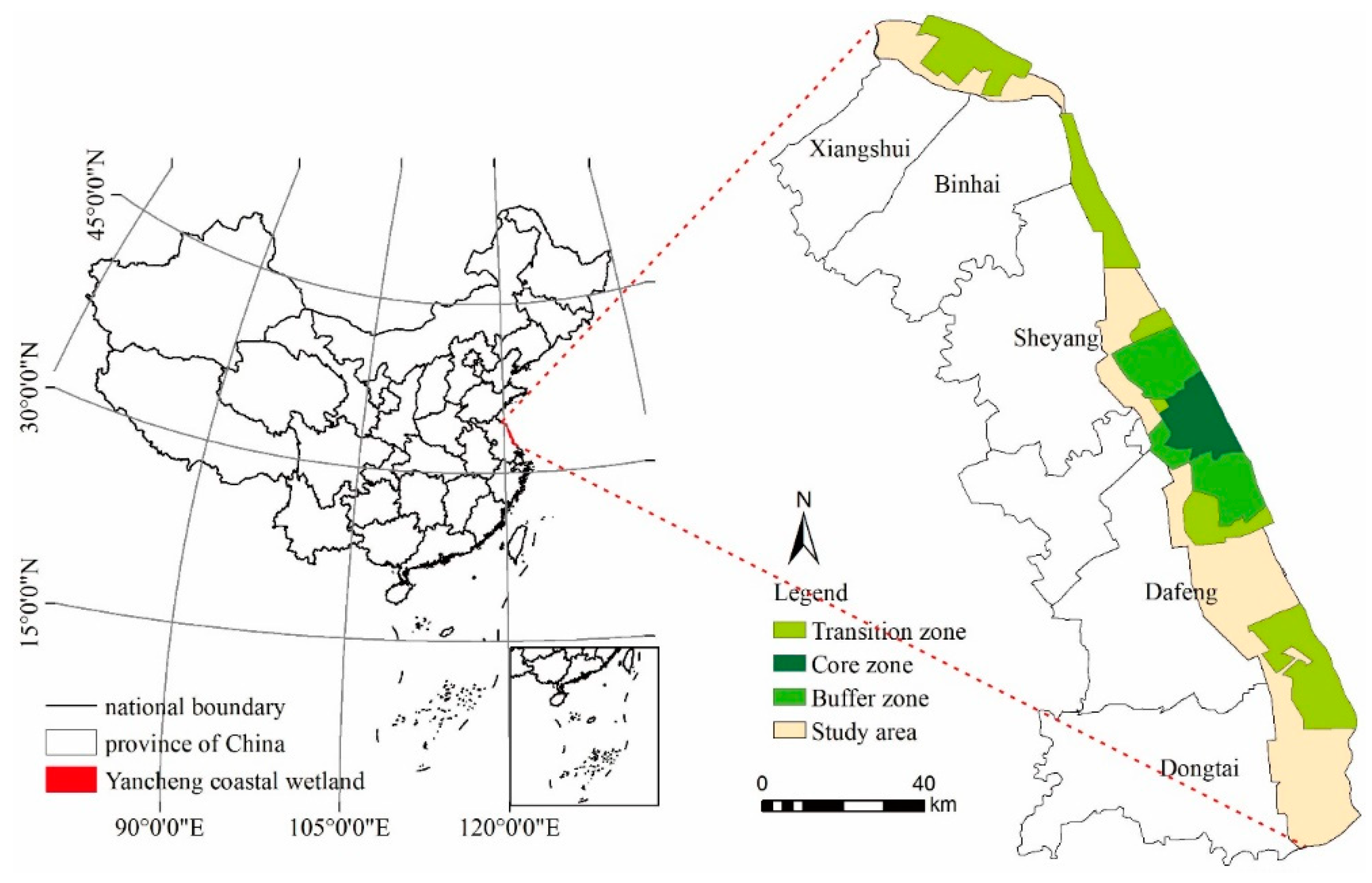
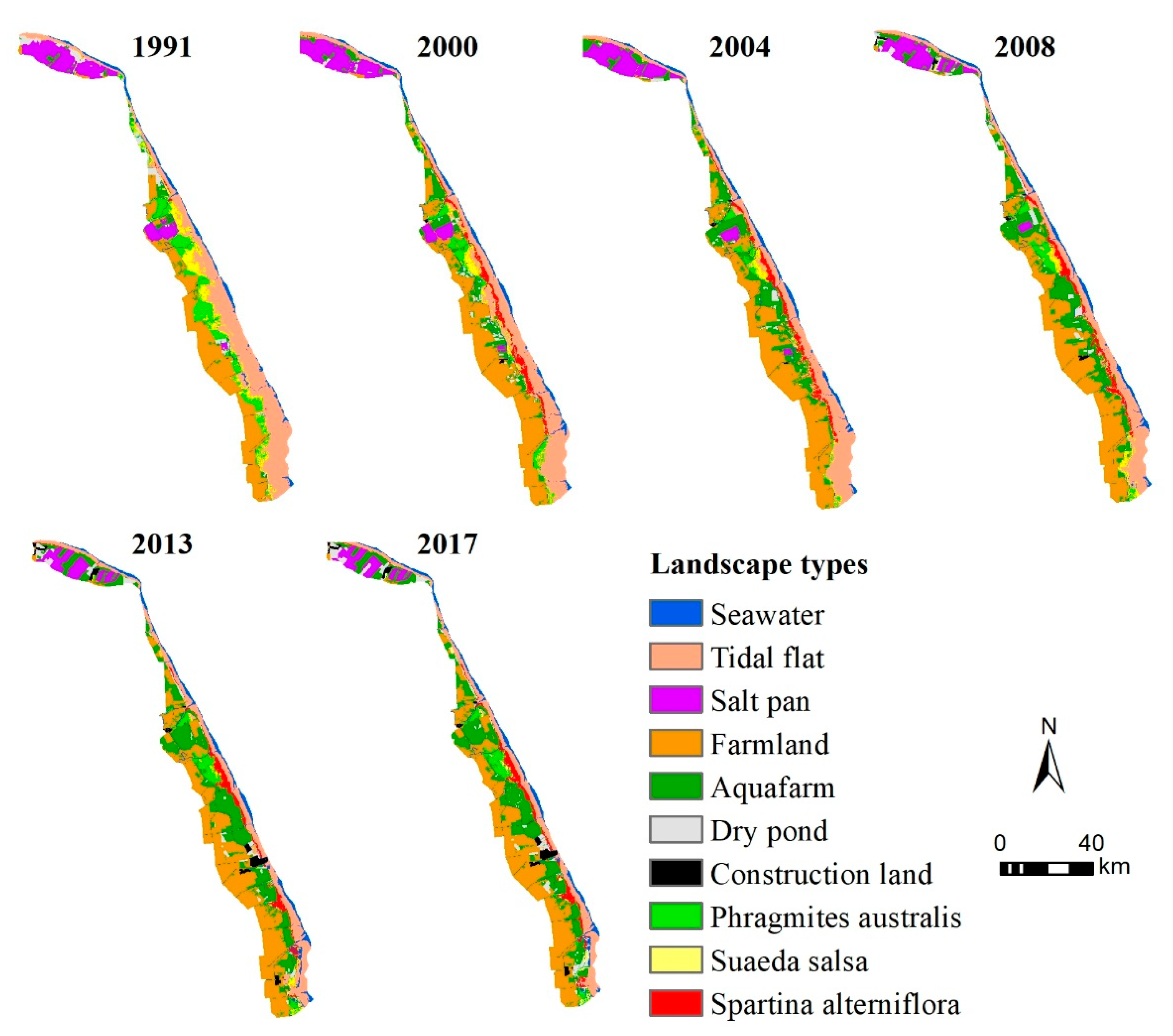
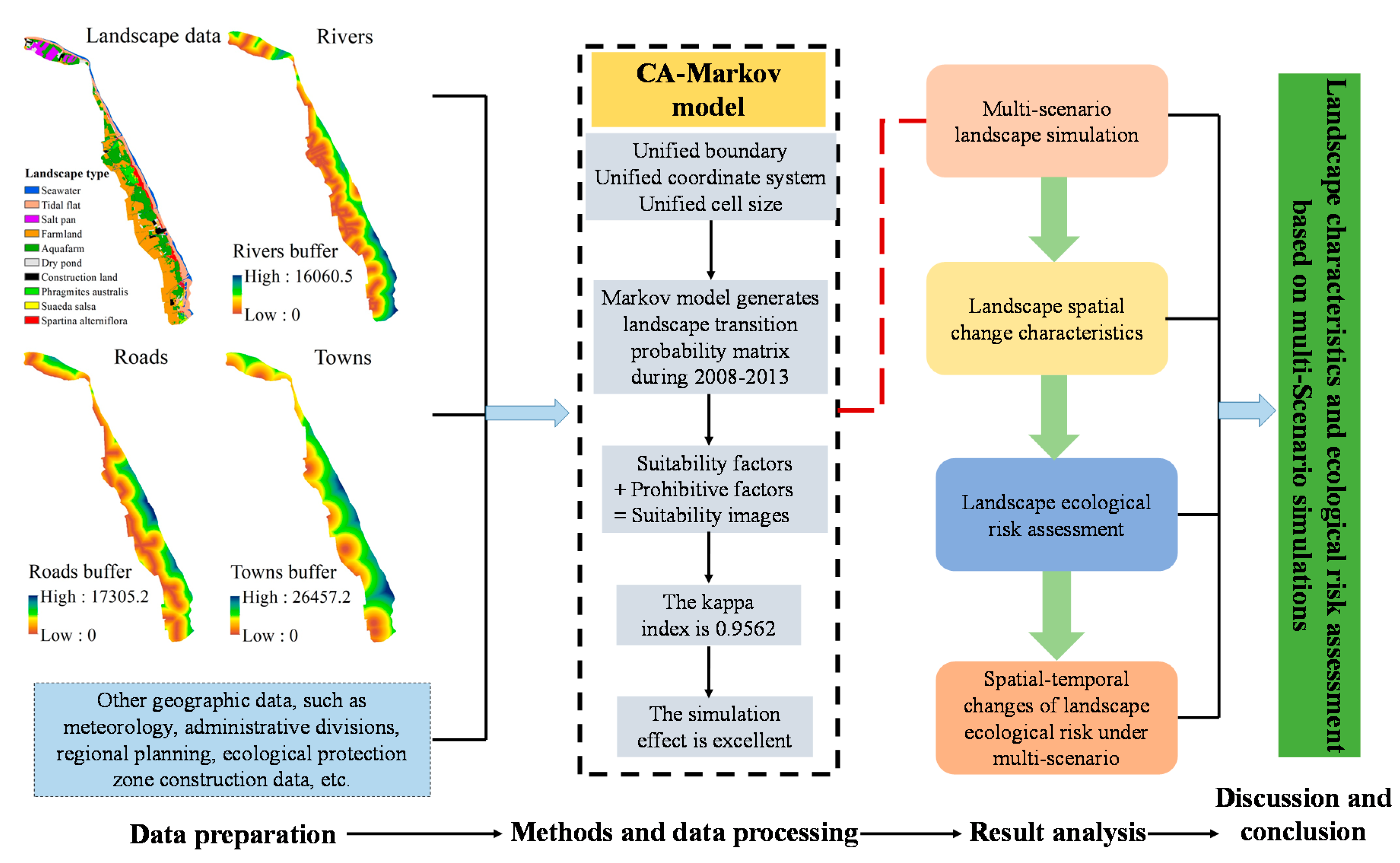
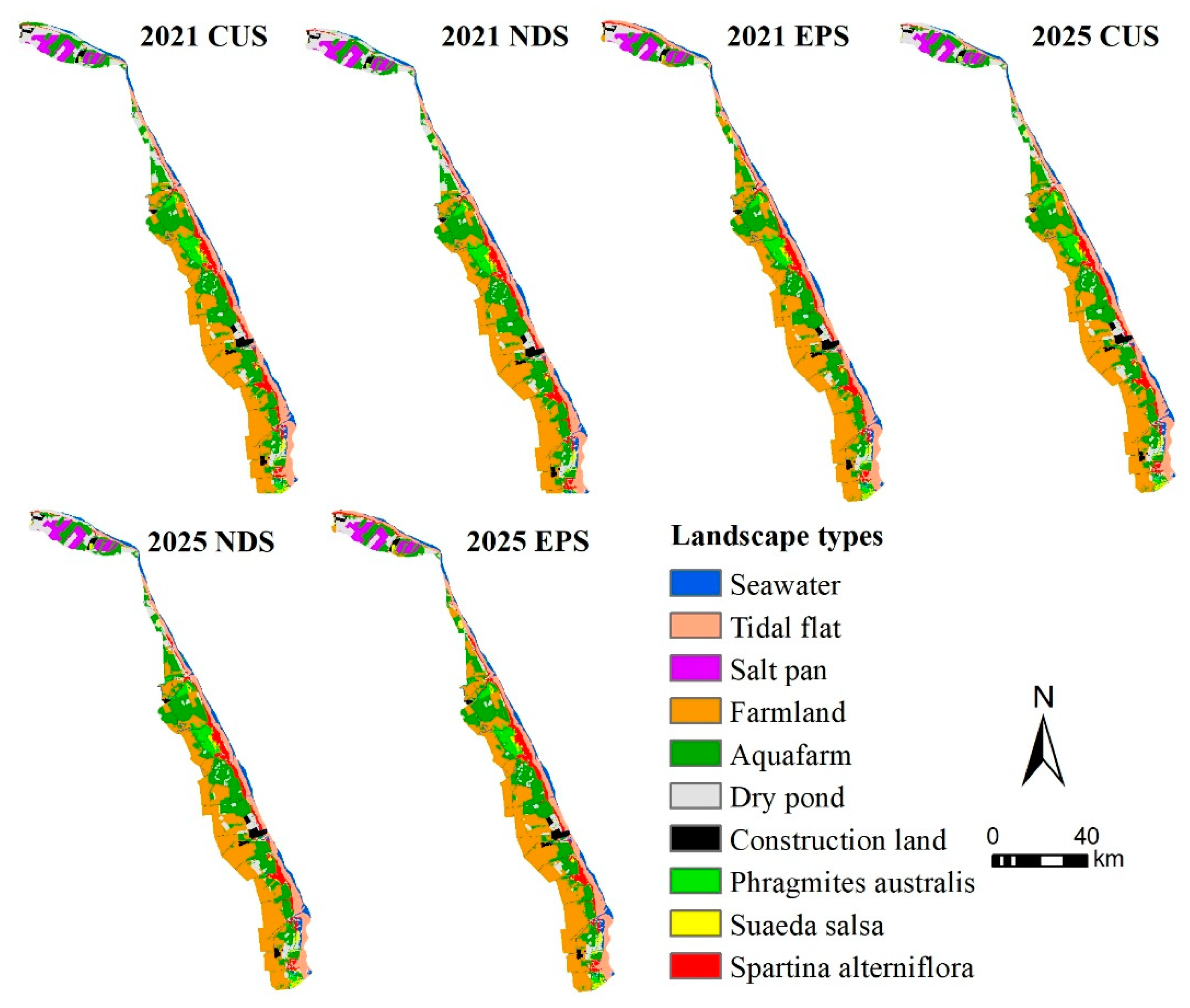

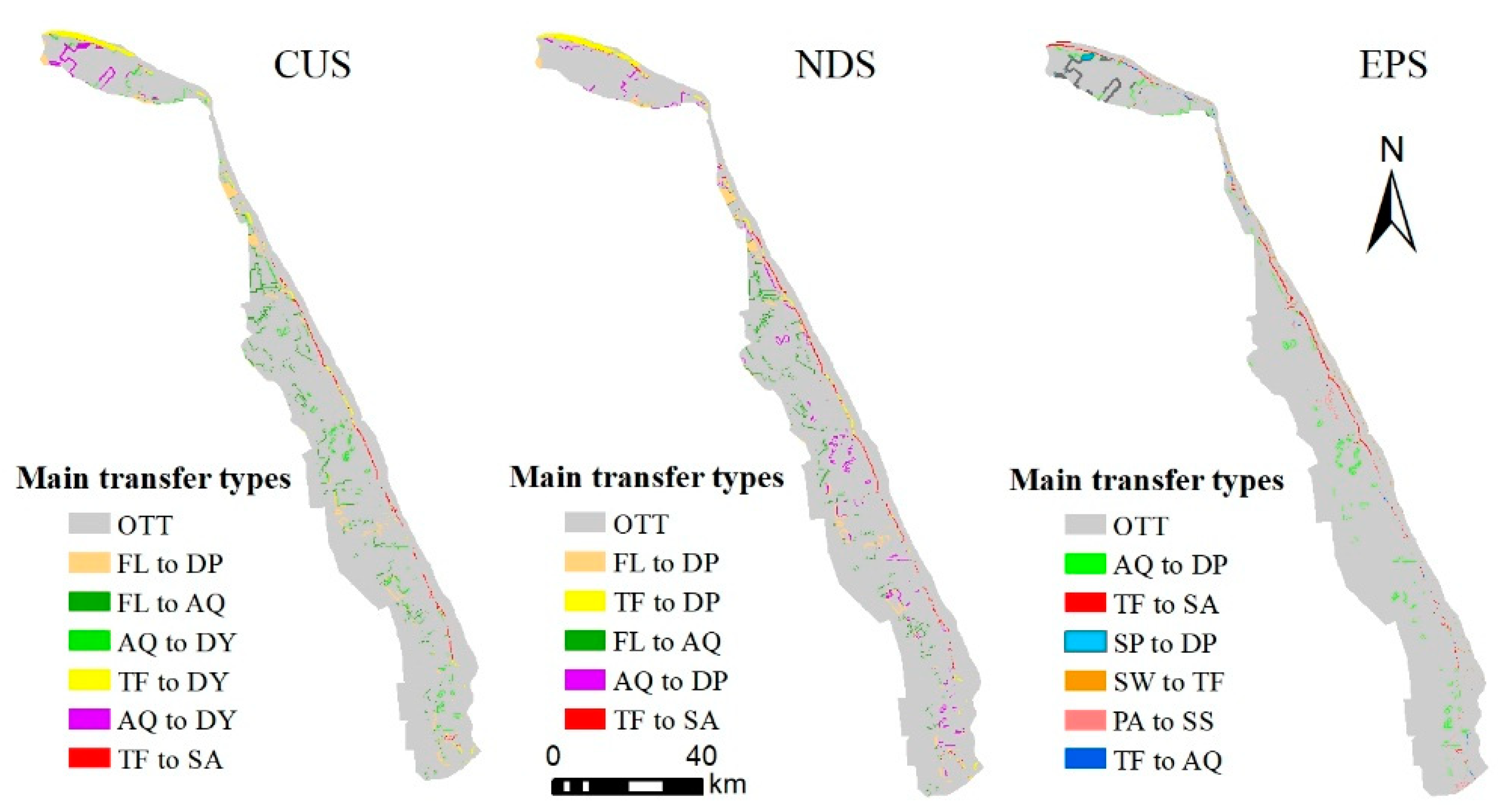
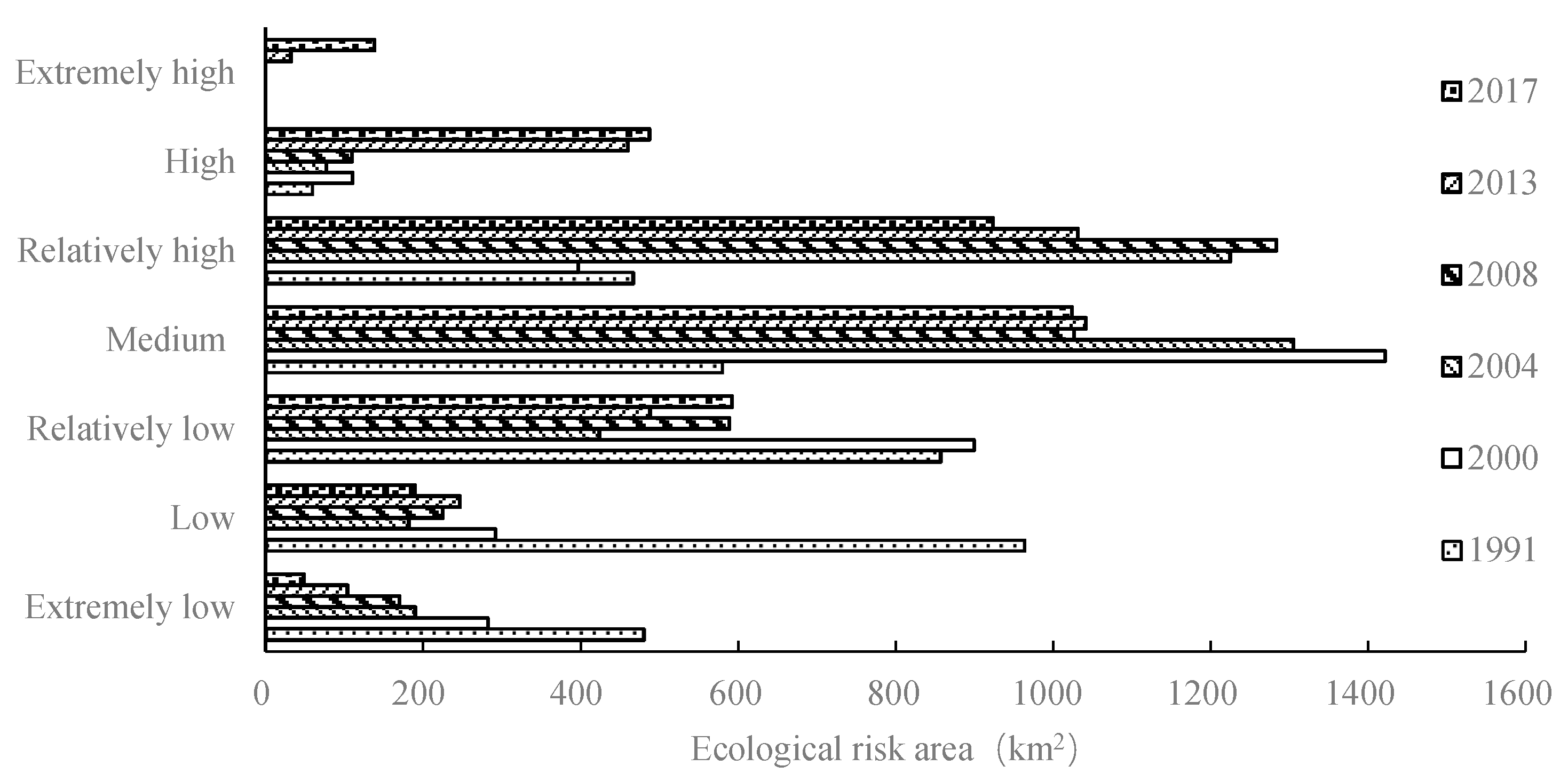
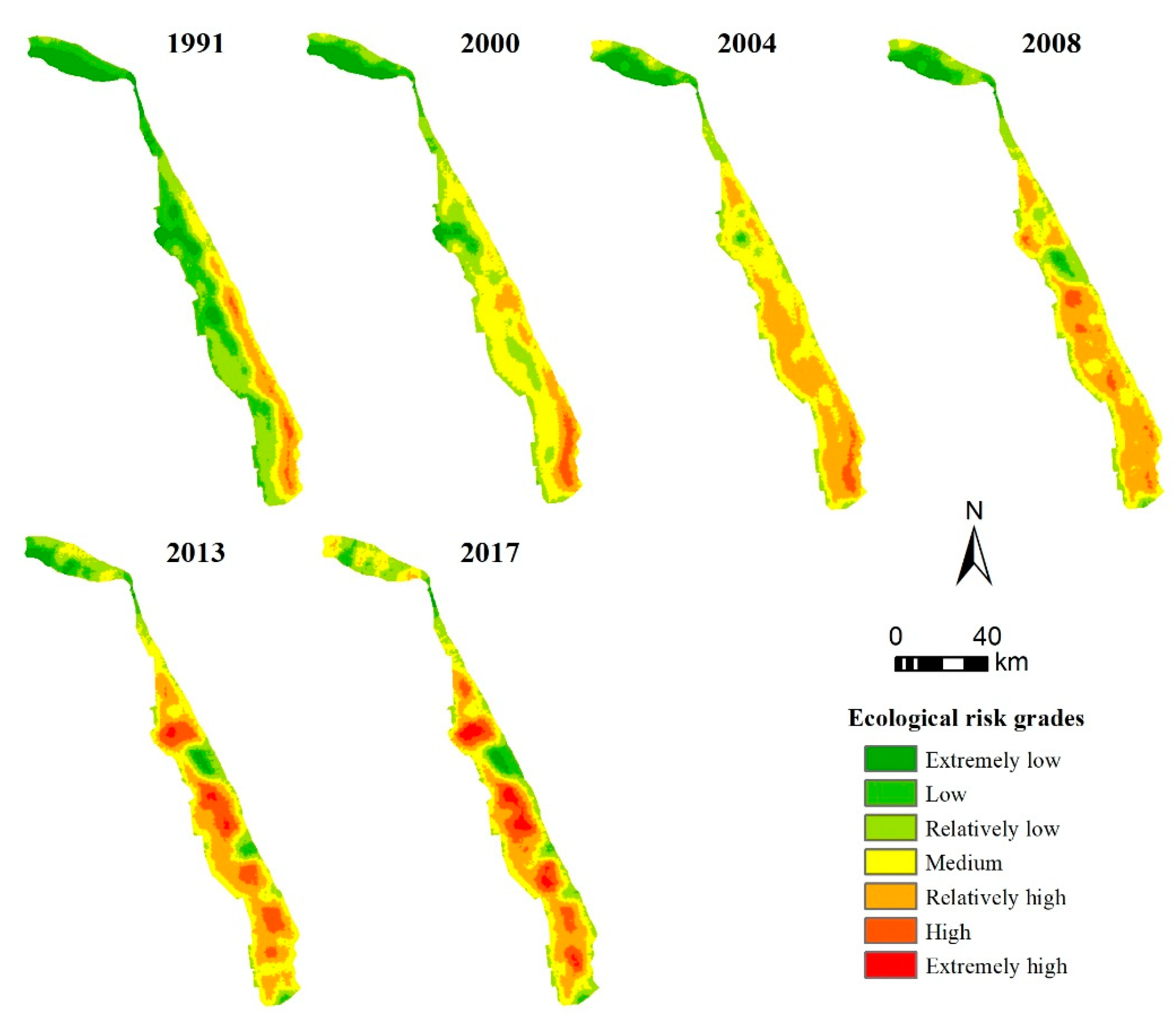
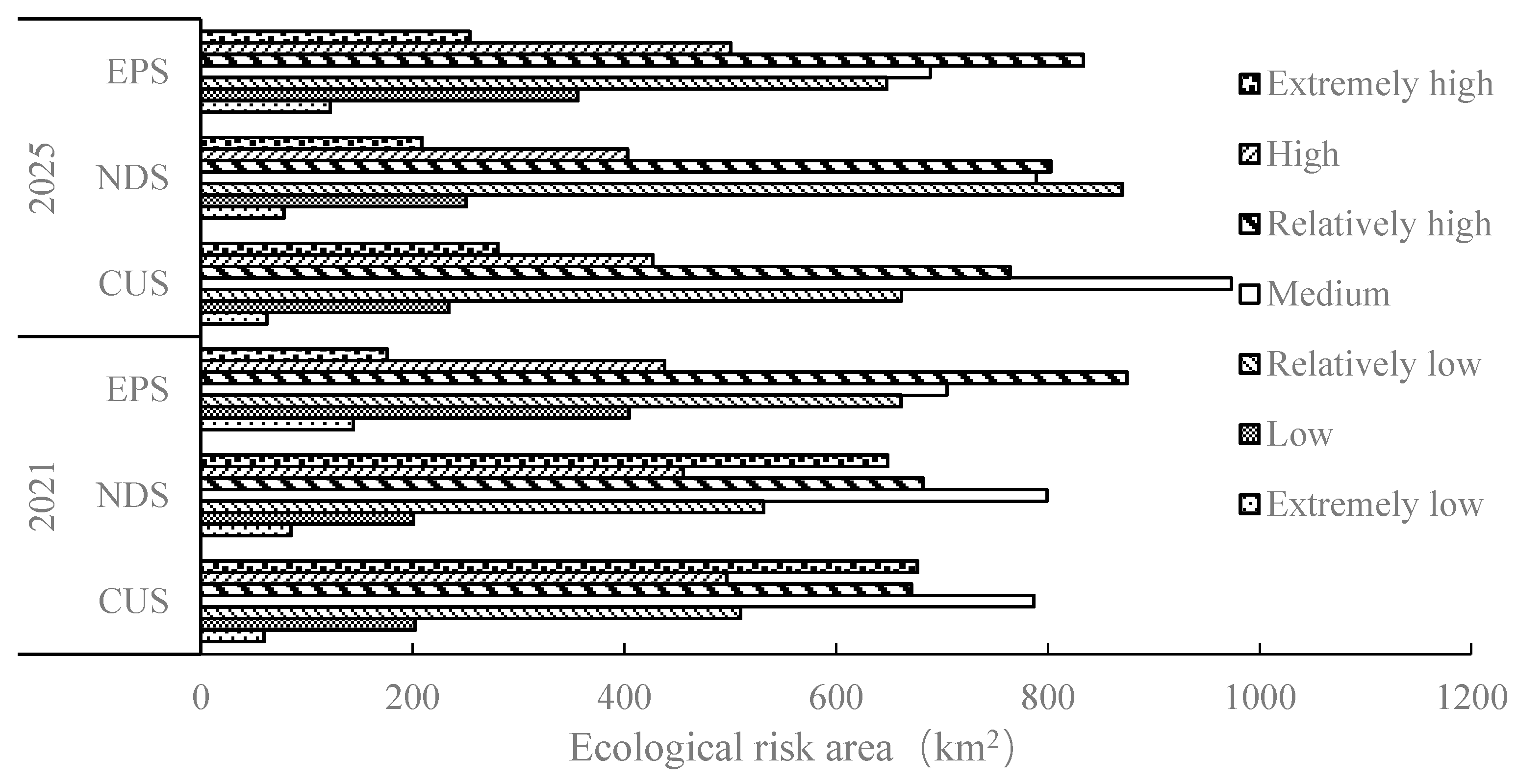
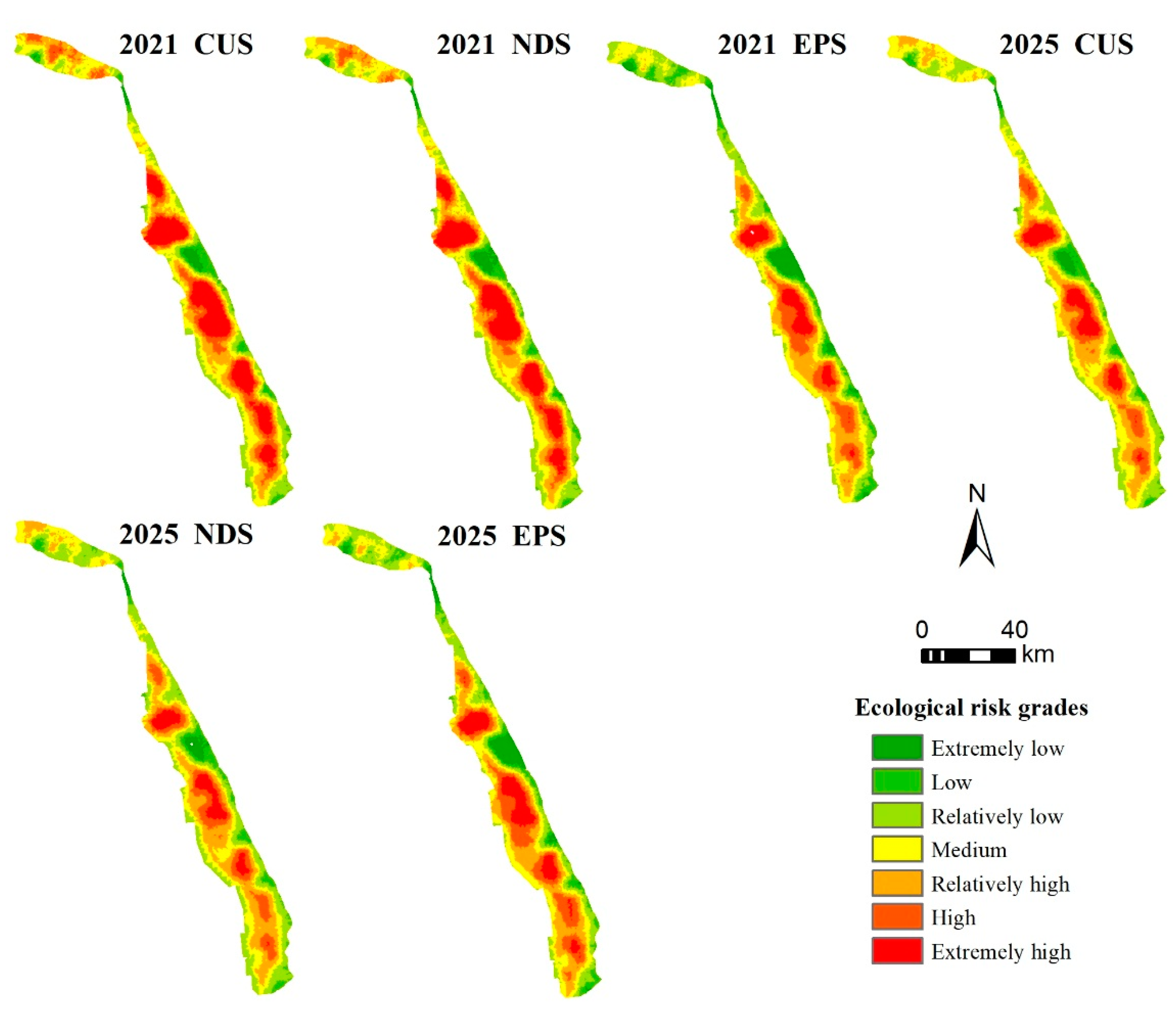
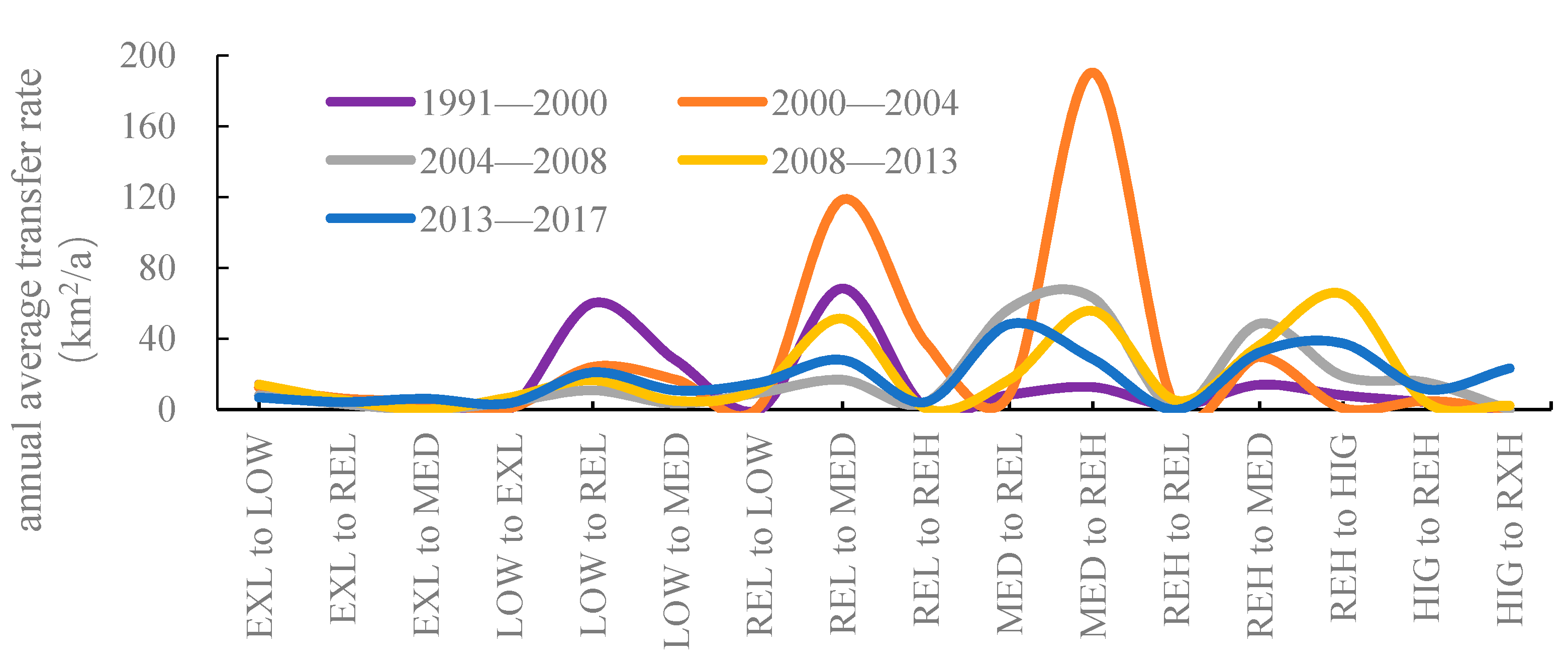
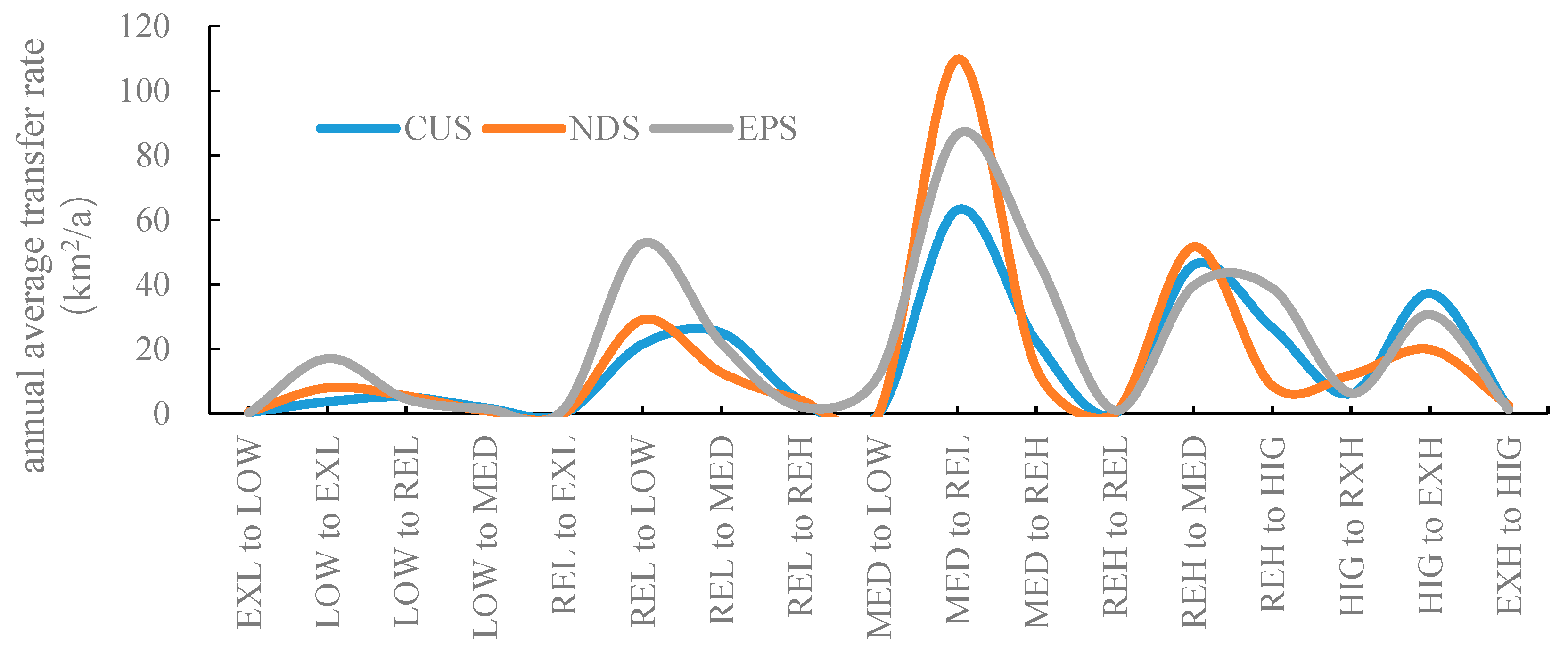
Publisher’s Note: MDPI stays neutral with regard to jurisdictional claims in published maps and institutional affiliations. |
© 2020 by the authors. Licensee MDPI, Basel, Switzerland. This article is an open access article distributed under the terms and conditions of the Creative Commons Attribution (CC BY) license (http://creativecommons.org/licenses/by/4.0/).
Share and Cite
Tian, P.; Cao, L.; Li, J.; Pu, R.; Gong, H.; Li, C. Landscape Characteristics and Ecological Risk Assessment Based on Multi-Scenario Simulations: A Case Study of Yancheng Coastal Wetland, China. Sustainability 2021, 13, 149. https://doi.org/10.3390/su13010149
Tian P, Cao L, Li J, Pu R, Gong H, Li C. Landscape Characteristics and Ecological Risk Assessment Based on Multi-Scenario Simulations: A Case Study of Yancheng Coastal Wetland, China. Sustainability. 2021; 13(1):149. https://doi.org/10.3390/su13010149
Chicago/Turabian StyleTian, Peng, Luodan Cao, Jialin Li, Ruiliang Pu, Hongbo Gong, and Changda Li. 2021. "Landscape Characteristics and Ecological Risk Assessment Based on Multi-Scenario Simulations: A Case Study of Yancheng Coastal Wetland, China" Sustainability 13, no. 1: 149. https://doi.org/10.3390/su13010149
APA StyleTian, P., Cao, L., Li, J., Pu, R., Gong, H., & Li, C. (2021). Landscape Characteristics and Ecological Risk Assessment Based on Multi-Scenario Simulations: A Case Study of Yancheng Coastal Wetland, China. Sustainability, 13(1), 149. https://doi.org/10.3390/su13010149







